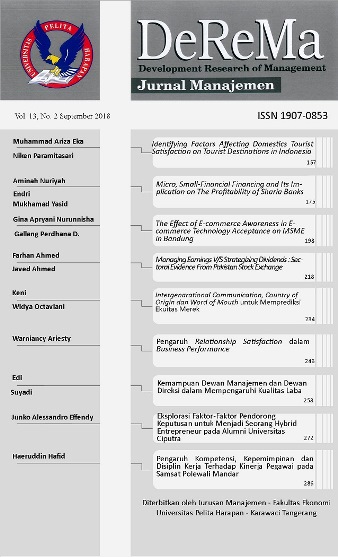Intergenerational Communication, Country of Origin Dan Word of Mouth Untuk Memprediksi Ekuitas Merek [Intergenerational Communication, Country of Origin and Word of Mouth for Predicting Brand Equity]
##semicolon##
https://doi.org/10.19166/derema.v13i2.863##semicolon##
intergenerational communication##common.commaListSeparator## country of origin##common.commaListSeparator## word of mouth##common.commaListSeparator## brand equity##common.commaListSeparator## smartphone要旨
The purpose of this research are to examine whether intergenerational communication, country of origin, and word of mouth can predict brand equity. The population of this research is smartphone consumers. The sample is of 200 smartphone consumers in Jakarta using online questionnares with the nonprobability sampling technique with convenience sampling. The data analysis used in this study was multiple regression analysis. The results of this study are intergenerational communication, country of origin and word of mouth are positively and significantly predictors of brand equity.
Abstrak dalam Bahasa Indonesia : Penelitian ini dilakukan untuk menganalisis pengaruh komunikasi intergenerasi, country of origin dan word of mouth terhadap ekuitas merek. Populasi dalam penelitian ini adalah para pengguna ponsel pintar di Indonesia. Proses pengambilan data dilakukan dengan menyebarkan kuesioner kepada 200 konsumen ponsel pintar di Jakarta dengan teknik sampling non probabilitas berupa convenience sampling. Setelah data dikumpulkan, data kemudian dianalisis dengan menggunakan metode regresi linear berganda. Berdasarkan hasil analisis data, diperoleh hasil bahwa komunikasi intergenerasi, country of origin and word of mouth memiliki pengaruh positif dan signifikan terhadap ekuitas merek.
##submission.citations##
Alhaddad, A. A. (2015). The effect of advertising awareness on brand equity in social nedia. International Journal of e-Education, e-Business, e-Management and e-Learning, 5(2), 73-84. https://doi.org/10.17706/ijeeee.2015.5.2.73-84
Anugrah, M. F. (2015). Bos Xiaomi Raih penghargaan business man of the year. Retrieved 29 Sept. 2016 from http://economy.okezone.com/read/2015/04/10/213/ 1131968/bos-xiaomi-raih-penghargaan-business-man-of-the-year
Armelini, G. (2011). The effect of word of mouth in customer equity and brand equity. Chinese Business Review, 10(3), 205-216. https://doi.org/10.17265/1537-1506/2011.03.005
Bahrinizadeh, M., Esmaiilpoor, M., & Haraghi, M. (2014). Brand equity and country of origin model in pharmaceutical Industry. Journal of Business And Management, 3(6), 137-146. https://doi.org/10.12816/0018186
Bilkey, W. J., & Nes, E. (1982). Country-of-origin effects on product evaluations. Journal of International Business Studies, 13(1), 89-100. https://doi.org/10.1057/palgrave.jibs.8490539
Cai, Y., Zhao, G., & He, J. (2015). Influences of two modes of intergenerational communication on brand equity. Journal of Business Research, 68(1), 553-560. https://doi.org/10.1016/j.jbusres.2014.09.007
Delgado-Ballester, E., & Munuera-Aleman, J. (2005). Does brand trust matter to brand equity?. Journal of Product and Brand Management, 14(3), 187-96. https://doi.org/10.1108/10610420510601058
Freytag, J., & Rauscher, E. A. (2017). The importance of intergenerational communication in advance care planning: Generational relationships among perceptions and beliefs. Journal of Health Communication : International Perspectives, 22(6), 488-496. https://doi.org/10.1080/10810730.2017.1311971
Gil, R. B., Andres, E. F., & Salinas, E. M. (2007). Family as a source of consumer based brand equity. Journal Of Product and Brand Management, 16(3), 188-199. https://doi.org/10.1108/10610420710751564
Global Business. (2016). Persaingan ketat pasar ponsel pintar 2016. Retrieved 29 Sept. 2016 from http://e-globalbusiness.com/2016/01/persaingan-ketat-pasar-smartphone-2016
Hanaysha, J. (2016). Examining the link between word of mouth and brand equity: A study on international fast food restaurants in Malaysia. Journal of Asian Business Strategy, 6(3), 41-49. https://doi.org/10.18488/journal.1006/2016.6.3/1006.3.41.49
Hanif, W. (2016). Ponsel pintar terbaik dan terlaris di Indonesia. Retrieved 29 Sept. 2016 from http://www.baikdanbenar.com/smartphone-terbaik-dan-terlaris-di-indonesia.html
Hawkins, D. I., & David, L. M. (2015). Consumer behavior: Building marketing strategy (13th ed.). Boston, MA: McGraw-Hill.
Jalilvand, M. R., Esfahani, S. S., & Samiei, N. (2011). Electronic word of mouth: Challenges and opportunities. Procedia Computer Science, 3(1), 42-46.
Japutra, A., Keni, K., & Nguyen, B. (2015). The impact of brand logo identification and brand logo benefit on Indonesian consumers’ relationship quality. Asia Pacific Journal of Business Administration, 7(3), 237-252. https://doi.org/10.1108/APJBA-10-2014-0124
Japutra, A., Keni, K., & Nguyen, B. (2016). What’s in a university logo? Building commitment in higher education. Journal of Brand Management, 23(2), 137-152. https://doi.org/10.1057/bm.2016.1
Keller, K. L. (2013). Strategic brand management: Building, measuring, and managing brand equity (4th ed.). Harlow, England: Pearson.
Kotler, P., & Keller, K. L. (2015). Marketing management. Boston, MA: Pearson Education.
Kominfo. (2015). Indonesia raksasa teknologi digital Asia. Retrieved 29 Sept. 2016 from https://kominfo.go.id/content/detail/6095/indonesia-raksasa-teknologi-digital-asia/0/sorotan_media
Leifeld, J. P. (1993). Experiments on country of origin effects: Review and meta-analysis of effect size. In N. Papadopoulos & L. Heslop (Eds.), Product-country images : impact and role in international marketing (117-156). New York: International Business Press, 117-156.
Lin, M-C., Harwood, J., & Hummert, M.L. (2008). Young adults' intergenerational communication schemas in Taiwan and the USA. Journal of Language and Social Psychology, 27(1), 28-50. https://doi.org/10.1177/0261927x07309510
Maholtra, N. K. (2010). Marketing research: An applied orientation (6th ed.). Upper Saddle River, NJ: Pearson Education.
Murtiasih, S., Sucherly & Siringoringo, H. (2013). How word of mouth influence brand equity for automotive products in Indonesia. Procedia-Social And Behavioral Sciences, 81(1), 40-44. https://doi.org/10.1016/j.sbspro.2013.06.384
Murtiasih, S., Sucherly, & Siringoringo, H. (2014). Impact of country of origin and word of mouth on brand equity. Marketing Intelligence and Planning, 32(5), 616-629. https://doi.org/10.1108/MIP-04-2013-0073
Panda, R. K., & Misra, S. (2014). Impact of country-of-origin image on brand equity: A study on durable products in India. Procedia-Social And Behavioral Sciences, 150(1), 494-499. https://doi.org/10.1016/j.sbspro.2014.09.062
Pappu, R., Quester, P. G., & Cooksey, R. W. (2006). Consumer based brand equity and country of origin relationships. European Journal of Marketing, 40(5), 696-717. https://doi.org/10.1108/03090560610657903
Sanyal, S. N., & Datta, S. K. (2011). The effect of country of origin on brand equity: An empirical study on generic drugs. Journal of Product and Brand Management, 20(2), 130-140. https://doi.org/10.1108/10610421111121125
Sugiyono. (2006). Metode penelitian pendidikan, pendekatan kuantitatif, kualitatif dan R&D. Bandung, Indonesia: Alfabeta.
Taghizadeh, H., Taghipourian, M. J., & Khazaei, A. (2013). The effect of customer satisfaction on word of mouth communication. Research Journal of Applied Sciences, Engineering and Technology, 5(8), 2569-2575. https://doi.org/10.19026/rjaset.5.4698
Virvilaite, R., Tumasonyte, D., & Sliburyte, L. (2015). The influence of word of mouth communication on brand equity: Receiver perspectives. Procedia-Social and Behavioral Sciences, 213(1), 641-646. https://doi.org/10.1016/j.sbspro.2015.11.465
Xu, J. B., & Chan, A. (2010). A conceptual framework of hotel experience and customer based brand equity. International Journal of Contemporary Hospitality Management, 22(2), 174-193. https://doi.org/10.1108/09596111011018179
Vin, T. T., & Huy, L. V. (2016). The relationships among brand equity, brand preference, and purchase intention: Emperical evidence from the motorbike market in Vietnam. International Journal of Economics and Finance, 8(3), 75-84. https://doi.org/10.5539/ijef.v8n3p75
Wilson, N., Theodorus, E., & Tan, P. (2018). Analysis of factors Influencing green purchase behavior: A case study of the cosmetics industry In Indonesia, Jurnal Muara Ilmu Sosial, Humaniora, dan Seni, 2(1), 453-464.
Yasin, N. M., Noor, M. N., & Mohamad, O. (2007). Does image of country of origin matter to brand equity? Journal of Product and Brand Management, 16(1), 38-48. https://doi.org/10.1108/10610420710731142
##submission.downloads##
出版済
巻号
セクション
##submission.license##
Authors who publish with this journal agree to the following terms:
1) Authors retain copyright and grant the journal right of first publication with the work simultaneously licensed under a Creative Commons Attribution License (CC-BY-SA 4.0) that allows others to share the work with an acknowledgement of the work's authorship and initial publication in this journal.
2) Authors are able to enter into separate, additional contractual arrangements for the non-exclusive distribution of the journal's published version of the work (e.g., post it to an institutional repository or publish it in a book), with an acknowledgement of its initial publication in this journal.
3) Authors are permitted and encouraged to post their work online (e.g., in institutional repositories or on their website). The final published PDF should be used and bibliographic details that credit the publication in this journal should be included.





